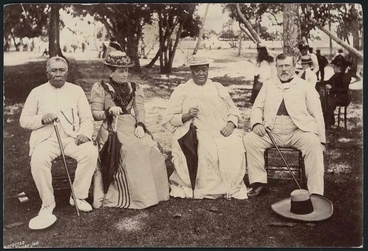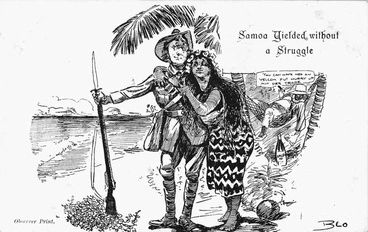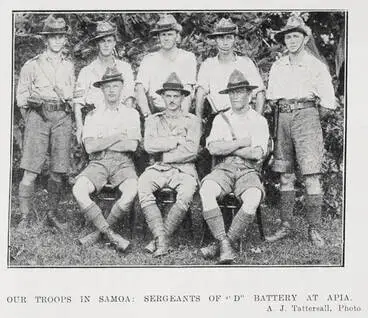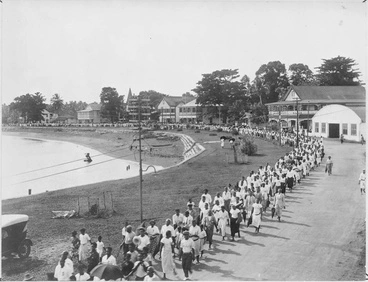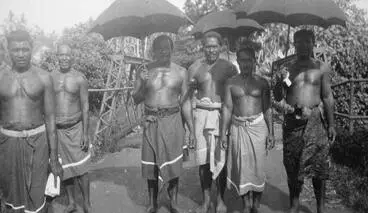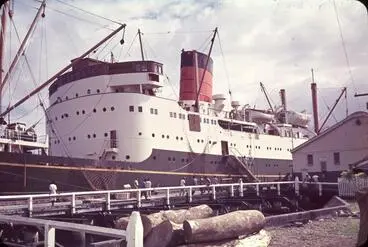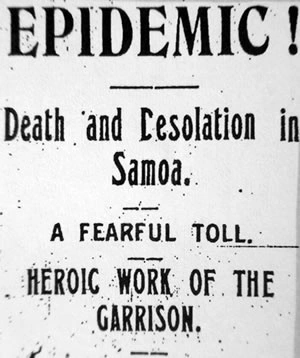New Zealand's Presence in the Pacific
A DigitalNZ Story by National Library Services to Schools
New Zealand is a country in the South Pacific that has very strong historic, cultural and economic ties to other Pacific island states and territories.
New Zealand in the Pacific Ocean
Manatū Taonga, the Ministry for Culture and Heritage
CONTENTS
This story on the Pacific Islands and New Zealand covers the following:
- Influenza
- Smallpox
- Measles
- Typhoid
- Tuberculosis
- Sanatoriums
- Polio
- Late 20th & early 21st-century epidemics
- Quick facts
- Department of Health posters
- Supporting resources.
BACKGROUND
New Zealand is a South Pacific nation with strong cultural, economic and political ties with other Pacific states and territories. People of Pacific Island descent were 7.4% of the total population in 2013. Auckland, with a quarter of its population identifying themselves as Māori or Pasifika in 2013, was regularly described as the world’s largest Polynesian city. Since 1993, Pacific Islanders have held seats in New Zealand’s Parliament.
Source: Pacific Islands and New Zealand - New Zealand and the Pacific, Te Ara - the Encyclopedia of New Zealand
New Zealand aid to the Pacific and elsewhere
Manatū Taonga, the Ministry for Culture and Heritage
Maintaining culture
Manatū Taonga, the Ministry for Culture and Heritage
NEW ZEALAND'S ROLE WITH THE PACIFIC ISLANDS
Although a small nation in international terms, New Zealand is relatively large and powerful in the Pacific. Foreign policy has focused on achieving or sustaining political stability, and on trade, development aid and managing political crises. The Pacific Islands Forum, the main regional political body, was set up in 1971.
Immigration and aid
After the Second World War, close links, job opportunities and population pressure on some islands led many Pacific people to migrate to New Zealand. During the 1970s the government clamped down on people overstaying their visas, particularly targeting Pacific Islanders.In 2011 about 8% of New Zealand’s population were of Pacific descent, and over half of New Zealand aid went to the Pacific.
Colonisation and trade
The ancestors of Māori came to New Zealand from Polynesia around 1250–1300. From the late 18th century Pacific-bound whaling ships visited New Zealand, and in the 19th century many politicians advocated colonising the Pacific Islands.
Samoa
After Germany withdrew from the Pacific during the First World War, Western Samoa came under New Zealand control. From 1927 the Mau movement pushed for self-government. New Zealand reacted harshly, arresting Mau supporters and firing on a peaceful protest in 1929, killing at least nine Samoans. However, New Zealand later supported Western Samoa becoming independent, in 1962.
Cook Islands and Niue
The Cook Islands and Niue became New Zealand’s first Pacific colonies in 1901. From 1965 the Cooks were self-governing; so was Niue from 1974. Cook Islanders and Niueans remained New Zealand citizens.
Tokelau
Tokelau came under New Zealand control in 1925. In 2020 it remained a dependent territory. Tokelauans are New Zealand citizens. From the 19th century Fiji supplied unprocessed sugar to New Zealand factories. A British colony from 1874, it became an independent democracy in 1970. New Zealand was involved in attempts to stabilise Fiji after coups in 1987, 2000 and 2006.
Tonga
In 2006 New Zealand troops were sent to Tonga after riots in Nuku’alofa, and in 2010 King George Tupou V agreed to new democratic arrangements.
Melanesia
In the 19th century New Zealand missionaries were active in Melanesia. During the Second World War New Zealand troops fought the Japanese in the Solomon Islands. In the 1990s New Zealand helped broker a peace agreement in Bougainville.After a coup in the Solomon Islands in 2000, New Zealanders attempted to resolve the crisis, and from 2003 until 2017 took part in a multinational force in the Solomons.
Source: Pacific Islands and New Zealand, Te Ara - the Encyclopedia of New Zealand
Pisupo lua afe (Corned Beef 2000) is a sculpture made from flattened corned beef tins by Michel Tuffery.
Museum of New Zealand Te Papa Tongarewa
NEW ZEALAND'S SPECIAL RELATIONSHIP WITH THE PACIFIC
New Zealand has always been, geographically, a group of Pacific islands. As New Zealand’s identity has shifted away from being a distant outpost of the British Empire, it has increasingly emphasised linkages, both cultural and political, with other island nations in the Pacific. New sources of cultural inspiration – including those brought by Pacific migrants – have become important.
Generally, New Zealand has assumed greater responsibilities in Polynesia, while Australia has taken the leading role in Melanesia. New Zealand's first minister of Pacific Island affairs (Richard Prebble) was appointed in 1984. In 1990 the Pacific Island Affairs Unit became the Ministry of Pacific Island Affairs (later the Ministry for Pacific Peoples), which was concerned with the social, economic and cultural development of Pasifika in New Zealand.
Source: Pacific Islands and New Zealand - New Zealand and the Pacific, Te Ara - the Encyclopedia of New Zealand
Pacific Seddon
Manatū Taonga, the Ministry for Culture and Heritage
PACIFIC SEDDON
This 1900 newspaper cartoon depicts New Zealand Premier Richard Seddon in mock Pacific Island dress, with a Union Jack flag on his waistband. The cartoon was a comment on Seddon’s enthusiasm for empire-building. That year he had toured the Pacific, visiting many of the islands, including Rarotonga in the Cooks, which New Zealand was annexing. Like many New Zealand politicians, he believed that the Pacific Islands were New Zealand’s first line of defence against hostile foreign powers.
Source: Pacific Islands and New Zealand - Colonisation and trade in the Pacific - Pacific Seddon, Te Ara - the Encyclopedia of New Zealand
Richard Seddon in the Cook Islands
Manatū Taonga, the Ministry for Culture and Heritage
Samoa yielding postcard
Manatū Taonga, the Ministry for Culture and Heritage
INVADING SAMOA
On the outbreak of war in Europe in 1914, New Zealand sent a military expedition to take control of Western Samoa. New Zealand’s authority was initially as a technically British military administration and then, after the 1919 Treaty of Versailles, as the holder of a League of Nations Class C mandate.
Source: Pacific Islands and New Zealand - Samoa, Te Ara - the Encyclopedia of New Zealand
Our troops in Samoa
Auckland Libraries
Postcard, 'German War Flag captured at Samoa by New Zealand Expeditionary Force'
Museum of New Zealand Te Papa Tongarewa
New Zealand troops landing in Samoa
Alexander Turnbull Library
Mau leader Tamasese and his committee outside the Mau office at Vaimoso.
Alexander Turnbull Library
MAU REBELLION
The Mau rebellion, which began in 1927, was a peaceful movement for self-government or ‘Samoa mo Samoa’ (Samoa for the Samoans). Supporters wore a distinctive violet lavalava (wrap-around skirt) and published a newspaper, the Samoa Guardian. New Zealand responded forcefully to demonstrations, boycotts and other forms of civil disobedience, arresting 400 Mau supporters. On Saturday 28 December 1929, New Zealand military police fired on a peaceful Mau demonstration, killing at least nine Samoans, including high chief Tupua Tamasese Lealofi III.
Source: Pacific Islands and New Zealand - Samoa, Te Ara - the Encyclopedia of New Zealand
Mau parade
Manatū Taonga, the Ministry for Culture and Heritage
A Mau Movement demonstration in Apia Samoa
Alexander Turnbull Library
Mau supporters in 1930
Manatū Taonga, the Ministry for Culture and Heritage
'Nuclear Free Pacific' badge
Museum of New Zealand Te Papa Tongarewa
NEW ZEALAND'S ANTI-NUCLEAR PROTEST IN THE PACIFIC
France had conducted atmospheric nuclear tests at Mururoa (or Moruroa), an atoll 1250 km south-east of Tahiti, since 1966. When the French refused to accept an International Court of Justice injunction against atmospheric testing, New Zealand’s Labour government decided to alternately station two frigates, HMNZS Otago and Canterbury, in international waters outside the test area. A Cabinet minister would accompany this daring protest. Kirk put all their names into a hat and drew out that of Fraser Colman, the minister of immigration and mines. The opposition National Party declined an invitation to send a member of its shadow Cabinet on the Otago.
The protests had some success. In 1974, by which time 41 atmospheric tests had been conducted at Mururoa, the new French president, Valéry Giscard d’Estaing, decided that future testing would be held underground. Even so, the atoll remained a focus of anti-nuclear protest. The test site at Mururoa was dismantled following France’s last underground explosion in 1996.
Source: HMNZS Otago sails for Mururoa test zone, NZHistory
The South Pacific Nuclear-Free Zone Treaty.
Manatū Taonga, the Ministry for Culture and Heritage
FAST FACTS
- From 2015-2019 New Zealand provided $200 million in climate-related support to the small island developing states in the Pacific.
- New Zealand has also increased its Official Development Assistance funding over 2019-2022 to help Pacific countries reduce their vulnerability to the impacts of climate change and to build climate resilience.
- There are over 40 different Pacific ethnic groups living in New Zealand.
- 66 percent of Pacific peoples in New Zealand live in the Auckland region.
- New Zealand once invaded Samoa with nearly 1400 soldiers in 1914. German Samoa quickly surrendered. New Zealand went on to rule Samoa for the next 48 years.
- In 1863, the Ngāti Whātua chief, Pāora Tūhaere, sailed the Māori-owned Victoria, a 56-ton schooner, 3,000 kilometres to Rarotonga to trade with the locals there.
SUPPORTING RESOURCES
Decolonising the Pacific — the process of decolonisation was central in the way that New Zealand’s Pacific migration unfolded writes Damon Salesa.
Has the ‘New Zealand dream’ turned sour — Pacific Islanders make up 15% of Auckland’s population. But does the dream of a better life match reality?
How NZ took influenza to Samoa — within days, people were dying. Within weeks, entire villages had died.
New Zealand — our role in the Pacific slave trade is "a dark piece of our history."
New Zealand’s invasion of Samoa in 1914 — A look at the first New Zealand military action in the First World War, the acquisition of German Samoa on August the 29th 1914.
New Zealand Pacific peoples — the statistics here cover well-being, language and culture, health and disability, housing, and work (both paid and unpaid) and income, as well as population size.
New Zealand’s Pacific reset — strategic anxieties about China’s expanding influence in the Asia-Pacific region.
Our work in the Pacific — New Zealand is serious about addressing climate change at home and in the neighbouring Pacific Islands.
A Pacific country — New Zealand is a Pacific country connected to the region by culture, history, politics, people, language, and shared interests.
Pacific aid map overview— this map provides an overview of aid flows to the Pacific region. There are four layers to the map, enabling users to zoom down to level of individual projects.
Pacific peoples — Pacific Values are our anchor, with each generation weaving the foundation for the next to stand on.
The Pacific - Te Moananui-a Kiwa — People, places, pictures and stories that relate to the Pacific Ocean.
Pasifika people in New Zealand — In 2014, a widespread national consultation process was undertaken to understand the needs and priorities of Pacific families.
THE PACIFIC AND NEW ZEALAND: IMAGES
New Zealand. Legation (Washington, D.C.) :New Zealand fights in Pacific skies [1940s]
Alexander Turnbull Library
Pacific Island New Zealanders
Manatū Taonga, the Ministry for Culture and Heritage
Slide: MV TOFUA berthed at unidentified wharf
New Zealand Maritime Museum
Pacific migrants
Manatū Taonga, the Ministry for Culture and Heritage
Auckland Secondary Schools Maori and Pacific Islands Cultural Festival, Manukau City. Samoan performers, Avondale College
Museum of New Zealand Te Papa Tongarewa
South Pacific travel brochures, 1960s
Manatū Taonga, the Ministry for Culture and Heritage
Cap (New Zealand Pacific Party)
Museum of New Zealand Te Papa Tongarewa
Pacific rugby players
Manatū Taonga, the Ministry for Culture and Heritage
Tagged tuna
Manatū Taonga, the Ministry for Culture and Heritage
First Family umukai, or feast, to celebrate Empire Day, Palmerston Island.
Alexander Turnbull Library
Reporting Samoa's influenza pandemic
Manatū Taonga, the Ministry for Culture and Heritage
This story was curated and compiled by Te Puna Mātauranga o Aotearoa | National Library of New Zealand, Services to Schools staff, March 2020.



